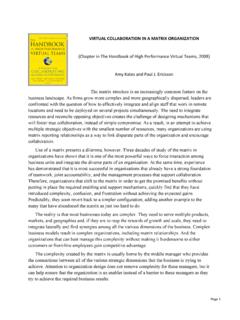Transcription of General Manager chapter--reformatted - Kates Kesler
1 The challenges of General Manager Transitions (This article originally appeared as Chapter #3 in Filling the Leadership Pipeline, Robert B. Kaiseer, editor; Center for Creative Leadership, 2005) Amy Kates and Diane Downey Downey Kates Associates There may be nothing more important to an organization s succession efforts than building a strong cadre of General managers. Yet making the transition to the General Manager role is fraught with difficulty. It is at this point where many successful careers derail (McCall & Lombardo, 1983; Shipper & Dillard, 2000). According to the Corporate Leadership Council, turnover among newly hired executives within the first three years of taking a new job is as high as fifty percent (as cited in Sweeny, 1999). Arthur Freedman's previous chapter explained myriad psychological challenges involved in managerial promotions.
2 We will use the "pathways-and-crossroads" framework he described in Chapter 2, as well as introduce some additional considerations to enrich the model. And whereas Freedman described how to apply the framework to transitions to the CEO level, we focus on the transition to the General Manager role. We define the General Manager position as involving broad, overall responsibility for a line of business or set of functions. It is the first level of management where managers have to lead other managers without first-hand knowledge of their disciplines. In many organizations, it is the first step into the executive ranks from middle management. For every CEO transition , there are dozens of transitions at this level. And the importance of these General Manager transitions is obvious: one of them is likely to be tomorrow's CEO.
3 Take the case of Phil, a brilliant aerospace engineer at a client organization. In just fifteen years after graduate school he had been rapidly promoted up through the technical ranks until he was a head of engineering at a large defense contractor. Two years ago he was promoted from a functional Manager to vice president in charge of a new product line. But Phil was unable to make the leap from being a functional Manager to a cross-functional leader at the General Manager level. The product launch was a failure, and Phil s credibility in the company suffered. Within eighteen months, he had left to go back to an engineering job at a smaller company. The shame of it was that Phil's General Manager career at the defense contractor didn't have to wind up as another derailment case. For one, he wasn't adequately prepared for the major transition .
4 Further, he didn't have much support from his new boss, HR, his team, a mentor, or even an outside coach as he made the move. And with a vague sense of what he had to let go of and add on to make the leap, he wasn't fully sure he even wanted the increase in scope and scale. In this chapter, we delve into the specific case of new General managers, with a particular focus on what the organization (hiring managers, human resources, and talent management staff) can do to support them and maximize the success rate of these key managerial moves. We will highlight some ways that managing the transition is different for those promoted from within and external hires. Throughout, we draw upon examples and share lessons learned from organizations we've studied and consulted to on the design and execution of General Manager transition plans over the last ten years.
5 The Value of General Managers General managers are the lifeblood of any business. Up to this point in their careers, managers are often Manager /producers. They are promoted because of their technical knowledge and because they can coach and guide subordinates in the execution of their work. Functional managers can troubleshoot and solve problems as they arise, since they have often faced similar issues themselves in the past. The General Manager role is decidedly different. When placed in this role for the first time, managers are responsible for work they may have no expertise in, or even little appreciation for. For instance, in her role as director of marketing, our client Celeste had been frequently frustrated by the finance unit at budget time. She always felt they were too conservative and didn t understand how marketing drove the dynamics of the business.
6 When Celeste was promoted to lead the business, the finance director now reported to her. She noted after her first year as a General Manager that one of her biggest struggles was not only understanding enough about finance to make good decisions but also letting go of her old attitudes and appreciating the value and perspective that the unit brought. It is precisely this ability to manage the unknown that distinguishes the General Manager role and makes it so valuable to an organization. When you can no longer fall back on functional expertise, then you must rely on the true management and influence skills of working through people and processes to make good decisions, implement change, and get results. Competencies such as assessing and hiring the right talent, setting up monitoring and feedback systems, and building a high performing team become more important than any in-depth technical knowledge that you bring to the position (for more on unique executive competencies, see Martineau, Laskow, Moye, Phillips, this volume).
7 When an organization s leaders know they have a set of General managers that can fill a variety of positions, then they have real bench strength. With bench strength, the organization is much better positioned to grow through acquisition, by launching new lines of business, or by reaching into new markets. The deliberate development and rotation of General managers is one of the most effective ways to transfer skills, best practices, and desired cultural norms across a dispersed and complex company. And of course, General managers are the primary source for senior executive talent. Drying up of the Management Pipeline Too many companies find their pipeline drying up at the General Manager level, and discover that they need to hire from outside in order to fill gaps at higher levels. Ram Charan (2005) has noted that, due to a lack of programs dedicated to grooming managers for top positions, 37 percent of Fortune 1000 companies are run by external recruits.
8 He cites a Corporate Leadership Council survey that found that almost half of companies who had hired members of their executive teams from outside reported that they did so because developing internal candidates would be either too expensive or too time-consuming. At the same time, overall demographic trends indicate that the demand for experienced managers and executives will only become more intense in the coming decades. In the United States, the demographic dip that followed the baby boom has resulted in a shortage of workers in their 30s and early 40s, the time when people are typically ready to make the turn to General Manager . (The baby bust, or Generation X, is generally considered to be made up of people born from 1965 to 1975.) In the 1990s, the number of workers between the ages of 25 and 34 declined by 14 percent (Watson Wyatt, 2003).
9 According to a study by the Bureau of Labor Statistics, when workers from the baby-boom generation begin to retire in the United States, it will create a gap of about ten million more jobs than there will be workers to fill them (cited in Frank, et al., 2004, p. 14). At the same time, other studies indicate that older workers are likely to retire later in the coming decade to make up for stock market losses and the shift from defined benefit pensions (that guarantee a retirement income) to defined contribution retirement plans (that are dependent on personal saving rates and the vagaries of the market). An AARP study shows that more than 63 percent of workers over 50 plan to work at least part-time in retirement. However, only 10 percent expect to be working full-time at the same type of work that they are currently engaged in (AARP, 2003).
10 Therefore, while there may be more older workers than ever in the workforce, we can expect that few will be in the same type of demanding management roles they now occupy. In fact, the same study reports that over half of those surveyed plan to work for enjoyment, not money. This gap will be felt especially acutely at the higher levels of organizations, as the leadership pipeline begins to run dry. The General Manager Career Turn Making the turn to General Manager represents a substantial step up in leadership and accountability. One primary difference from the functional Manager role is that the General Manager typically has full end-to-end accountability for a good portion of the business, along with profit and loss (P&L) responsibility. For example, at one of our clients, General managers were each responsible for sales, marketing, and product development for their line of business, with full P&L responsibility.














